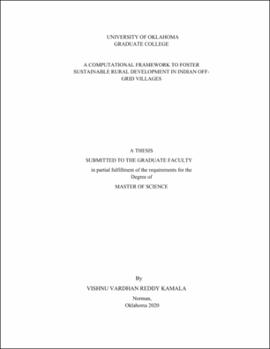| dc.description.abstract | Social problems are wicked problems. Wicked problems are very complex as there is no definitive solution due to its incompleteness. To achieve sustainable rural development, it is necessary to consider the wicked nature of the problem before developing solutions. There are millions of people in developing, and underdeveloped countries currently lacking access to basic services and are living below the poverty line. One of the main reasons is unavailability or limited basic resource (economic, technology, social) in geographical locations where people live. It is very important to identify the issues involved in a social system and come up with a value proposition to help a social entrepreneur to achieve sustainable rural development. A social entrepreneur establishes an enterprise intending to solve social problems or effect social change. Due to the implementation of the Corporate Social Responsibility (CSR) bill in 2013, the social entrepreneur’s service became easier in India. According to Corporate Social Responsibility (CSR) bill 2013, companies with an average net profit of at least 50 million rupees (approximately $816,000 USD) over a period of three years must spend 2% of their profits for the sustainable rural development in India.
In this thesis, a computational framework is proposed to facilitate social entrepreneurs to achieve sustainable rural development, especially in Indian off-grid villages that are facing extreme poverty. The intention of building this framework is to provide a method for social entrepreneurs, not results. Considering the wicked nature of the problem, in this framework, a decision-support method called ‘Dilemma Triangle’ is introduced to identify the dilemmas present in complex social issues. In villages at the bottom of the pyramid, most of the problems are related to basic needs like Food, Energy, and Water (FEW). In some villages, people cannot make use of available water to grow food as there is no electricity. In some villages, there won’t be a proper availability of water itself even though there is some electricity. This Food, Energy, and Water interdependency are explored in this thesis. Hence, the proposed decision-making method (Dilemma Triangle) which is the first half of the computational framework, is utilized in the FEW nexus to explore the problems related to FEW and find dilemmas that hinder sustainable development and develop the right value proposition. This value proposition is in the form of technology, asset, service-based, or a combination of the three. In the other half of the thesis, a simulation platform is used to evaluate the impact of the developed value propositions. In engineering, the performance of a developed product is tested in a simulation platform to make sure that the product is reliable. This idea is utilized in building the framework to generated scenario-based simulation model that allows any social entrepreneur to evaluate the impact their value proposition. This pre-production impact evaluation guides the social entrepreneur to plan their business operations strategically which allows them to do a proper budget planning and finally attract investors. To evaluate the impact of the value proposition, simulation models are built-in Systems Dynamics. Three scenarios are considered in this model: Worst case (pessimistic), Sufficient case (Realistic), and Best case (Optimistic). In the worst-case scenario, Systems Dynamics is used to show how a village could be without any interventions from social entrepreneurs. In a sufficient case scenario, Systems Dynamics is used to show, how the quality of life of villagers is being improved with a sufficient amount of value proposition is intervened. In the best-case scenario, the best possible help is provided to show the higher end of the development. Receiving maximum funds to implement the best-case scenario is not possible every time. Hence, a social entrepreneur should have a backup plan to initiate the interventions with a sufficient amount of money. This sufficient case is considered as the lower end, and the best-case is considered a higher-end. Since, lower and higher ends are available, by comparing the results of these scenarios, the budget range is decided. This visualization of the impact leads to the strategical planning of the business and raising more funds. This framework needs the right data to get the desired results. In this thesis, a method is proposed with internal consistency which provides desirable results with the right input. The outcome of this framework is intended to connect to a cloud-based crowdfunding platform in the future to display the anticipated results and budget range to attract investors from around the world. | en_US |
